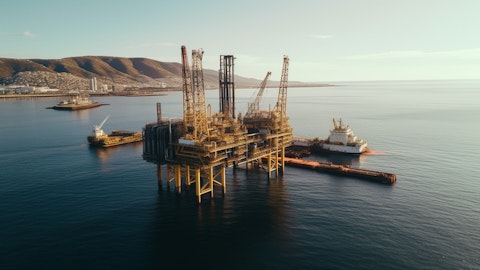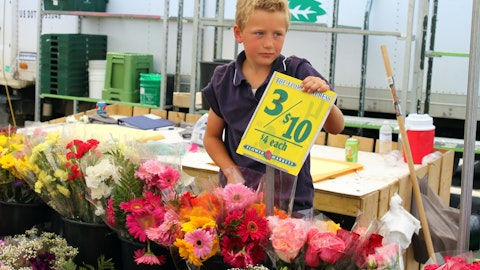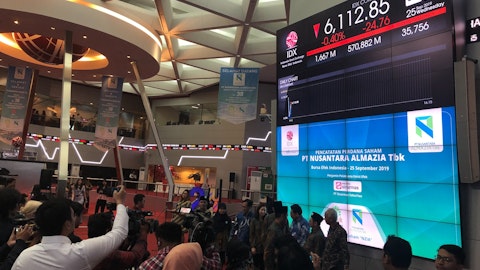Cenovus Energy Inc. (NYSE:CVE) Q4 2023 Earnings Call Transcript February 15, 2024
Cenovus Energy Inc. beats earnings expectations. Reported EPS is $0.39, expectations were $0.25. Cenovus Energy Inc. isn’t one of the 30 most popular stocks among hedge funds at the end of the third quarter (see the details here).
Operator: Good day, ladies and gentlemen, and thank you for standing by. Welcome to Cenovus Energy’s Fourth Quarter and Year-end 2023 Results. As a reminder, today’s call is being recorded. At this time, all participants are in a listen-only mode. Following the presentation, there will be a question-and-answer session. [Operator Instructions] Please be advised that this conference call may not be recorded or rebroadcast without the express consent of Cenovus Energy. I would now like to turn the conference call over to Mr. Jason Abbate, Senior Vice President, Investor Relations. Go ahead, Mr. Abbate.
Jason Abbate: Thank you, operator. Good morning, everyone, and welcome to Synovus’ 2023 year-end and fourth quarter results conference call. On the call this morning are CEO, Jon McKenzie, joined by Cenovus’ management team will take you through our results. Then we’ll open the line to take your questions. Prior to passing it over to Jon, I refer you to our advisories located at the end of today’s news release. Please describe the forward-looking information, non-GAAP measures and oil and gas terms referred to today. They also outline risk factors and assumptions relevant to this discussion. Additional information is available in Synovus’ annual MD&A and our most recent AIF and Form 40-F. All figures are presented in Canadian dollars and before royalties unless otherwise stated.

You can view the results on our website at cenovus.com. I ask that you keep to one question with a maximum of one follow-up. You’re welcome to rejoin the queue for any other follow-up questions you may have. Jon, please go ahead.
Jon McKenzie: Great. Thank you, Jason, and good morning, everybody. I’m going to highlight some important safety milestones that we achieved in the fourth quarter of 2023 and in the full year. We achieved a total recordable injury frequency of 0.31 in 2023. And importantly, we noted a marked decrease in the potential severity of our safety incidents, a trend we are very focused on continuously improving. 2023 was an important year, which included the restart of two refineries and the progression of the West White Rose project, which today stands at 75% complete. And we did this as we would expect, without a significant incident. I’m proud of the team for their continued focus on safety and what they’ve accomplished over the year.
Early in 2023, we signaled that the first two quarters of the year would be impacted by the startup of Superior and the delayed closing and start-up of Toledo. We also signaled that we expected to have our full suite of assets, operation available to us in the third and fourth quarters. Our fourth quarter reflects the results of the second consecutive quarter of operating or integrated value chain. Our upstream business continued to build on operating momentum. We increased production to nearly 810,000 barrels of oil per day, our highest quarterly number for this year and the second highest in the company’s history. This is something we are extraordinarily proud of. We saw a particularly strong performance at our oil sands assets, most notably at Foster Creek.
See also Top 30 Developing Countries in the World in 2024 and 10 Exclusive Dating Sites and Apps for Professionals.
Q&A Session
Follow Cenovus Energy Inc (TSE:CVE)
Follow Cenovus Energy Inc (TSE:CVE)
The ramp-up of new sustaining pads added about 10,000 barrels a day of increased production relative to the third quarter, taking this asset to nearly 200,000 barrels per day. We also started steaming, our first sustaining well pad at Sunrise, and we have two more well pads to bring on in 2024. This is the first step in our multiyear development of this asset that will see us push production volumes to or through nameplate capacity. Our upstream business generated an operating margin of about CAD 2.5 billion in the fourth quarter, and this reflects higher production, lower unit OpEx but also lower crude prices and wider heavy oil differentials. Now with the startup of the TMX pipeline, we anticipate light-heavy differentials to narrow. This is an important piece of infrastructure and creates additional egress in the Western Canadian basin and Cenovus’s an anchor shipper.
Our oil sands and thermal assets continue to perform exceptionally well as we enter 2024. We are focused on executing our capital plans at Christina Lake, Foster Creek, Sunrise in support of the organic growth of this business over the next two years. In our conventional business, fourth quarter production volumes remained steady around 124,000 BOE per day. And the business was consistent and stable after dealing with wildfires through much of the summer. Offshore production reached about 70,000 barrels a day in the fourth quarter, a 6% increase quarter-over-quarter. And in Asia Pacific, gas volumes were up by about 20% in Indonesia, as we brought on the MAC Field in September. Our Asia Pacific business continues to generate great — with great predictability, generating about $1 billion of operating margin for the year.
In the Atlantic region, the Terra Nova FPSO returned to production in late November, contributing about 4,000 barrels a day to Cenovus in the month of December. The operator has since seen a ramp-up of production in the field and is working towards the asset being increased to full rates. We also advanced work for the regulatory dry dock of the CROs FPSO. In late December, the vessel was taken off station. The vessel has now arrived in Belfast and maintenance work has begun. We anticipate the CROs to return in the third quarter of 2024. The investments we are making today ensure the vessel will be ready well in advance of the startup of the West White Rose project, supporting production from that field well into the late 2030s. Overall, it’s been a very strong quarter and a very strong start to 2024 for upstream businesses.
Consistent with our guidance, planned turnaround activity will occur in the third quarter, and we expect to grow production exiting the year at higher production rates. Turning to the downstream. The fourth quarter was another good step forward for our operated refining businesses. In Canadian refining crude utilization was 91% in the fourth quarter. The Lloydminster upgrader and refinery demonstrated consistent and strong performance. This performance has continued in the first quarter as we prepare for a major turnaround of the Lloydminster upgrader beginning in the second quarter. We anticipate the quarterly throughput impact to be about 42,000 to 46,000 barrels a day, consistent with guidance. And coming out of the turnaround, we expect the Lloyd complex to continue to run reliably, with high rates of utilization for the foreseeable future.
In US refining, our operated assets continue to run safely and reliably, performing mostly as expected. I’m very pleased with the improvements we continue to make in this business. The Toledo refinery ran steadily over the quarter and was able to take advantage of the wider light-heavy crude differentials. We also completed planned maintenance of the distillate hydrotreater at the Lima Refinery in the quarter. We expect this asset to run at high levels of utilization through the first three quarters of this year going into the fourth quarter turnaround. Now, we continue to have some challenges to the Superior refinery. You’ll see the throughput was in line with the prior quarter. We’re working to improve reliability, which will allow us to increase crude throughput and in the second quarter of 2024.
Our non-operated Borger Refinery underwent significant planned maintenance in the fourth quarter, and the operator experienced significant delays bringing the facility back up which impacted utilization and profitability in the quarter. This refinery is now operating at full rates. The most notable item in the fourth quarter results was the weak Chicago crack crush environment and volatility quarter-over-quarter. The Chicago 3:2:1 crack spread averaged US$13.24 per barrel, a decline of over 50% compared to the third quarter. The December crack averaged US$7.65 per barrel and at times gasoline cracks were negative, which caused us to respond by economically optimizing throughput. This not only drove lower US refining operating margin in the fourth quarter, but also lower throughput.
And contributed to a significant FIFO headwind in the US refining about $450 million as we processed higher priced crudes that were purchased in prior periods. Now, the weak crack environment has persisted through the month of January with an average Chicago 3-2-1 benchmark of about US$5.50 per barrel. But recently, the Chicago refining crack environment has improved. Cracks have risen into the low teens in the high 20s. And with seasonal impacts easing and product inventories rebalancing as well as refineries entering the turnaround season, we anticipate seeing more normalized cracks going forward. We expect to continuously improve our operating and financial performance in this business as we produce refined products into this pricing tailwind.
Now, to our corporate and financial performance. In the fourth quarter, Cenovus delivered approximately $2.1 billion of adjusted funds flow. As mentioned, the upstream business was impacted by lower realized prices with wider WTI-WCS differentials. And the downstream was impacted by lower refined product pricing in the US and a negative FIFO impact. Through our base dividend, share buybacks and final payment of the common share warrant obligation, we distributed over $700 million directly to our shareholders in the fourth quarter. In addition, the company’s net debt was approximately $5.1 billion at the end of the fourth quarter, a reduction of more than $900 million from the third quarter, which reflects a working capital release as well as the application of free cash flow.
We remain focused on achieving our $4 billion net debt target and delivering 100% of excess refunds flow to our shareholders once this milestone is met. So looking back at 2023, there are some important achievements, I’d like to highlight. We delivered safe and reliable upstream performance throughout the year, while responding to the significant wildfire activity in our conventional areas in the spring and summer, and safely executed a major turnaround at Foster Creek in the second quarter. We successfully delivered our capital spending guidance in 2023, with total investments of $4.3 billion and achieved several key project milestones as planned. We materially progressed construction of the West White Rose project, which, as I mentioned, is now about 75% complete and reached a major milestone in the second quarter with the completion of the Conoco slip form on the gravity-based structure.
At Christina Lake, we achieved approximately 45% completion of our Narrows Lake tieback pipeline on time and on budget. This will allow us to produce our high-quality, low SOR resource back to the Christina Lake processing facility. We further integrated our heavy oil production and refining capabilities through the acquisition of the remaining 50% of the Toledo Refinery, and we safely return that refinery to full operations in June. We brought Superior online and combined with Toledo, we added approximately 130,000 barrels a day of refining capacity much of that heavy oil refining capacity. We reduced our long-term debt by almost $1.6 billion, with US$1 billion of that being repurchased debt. We also strengthened our credit ratings during the year with a credit rating upgrade from Fitch ratings to BBB stable and a change in our Moody’s outlook from stable to positive.
We generated nearly $9 billion of adjusted funds flow in the year. This enabled us to deliver around $2.8 billion to shareholders through our base dividend, the purchase of common shares and the purchase and cancellation of about 46 million Cenovus warrants. We end 2023 on a strong note operation, and we’ll continue to build on this through the year. 2024 will be focused on achieving our $4 billion net debt target, progressing our high-return growth projects in the upstream and continuing to improve the profitability of the downstream business, while running it safely and reliably. Ultimately, as part of our capital allocation framework, we look forward to shifting to 100% of excess free funds flow going back to shareholders. We are well positioned as a company.
The achievements I just spoke to set us up well for 2024 and will continue to generate value for years to come. On March 5, we’ll be hosting an Investor Day, and I welcome you to attend to hear more about our strategy and detailed five-year plans at that time. And with that, I’ll stop, and we’re happy to take your questions.
Operator: [Operator Instructions] We will now begin the question-and-answer session and go to the first caller. And comes from Dennis Fong at CIBC World Markets. Please go ahead.
Dennis Fong : Hi. Good morning and thanks for taking my questions. Maybe starting with the downturn here — yes, good morning. Maybe starting with the downstream here. Do you mind discussing some of the opportunities that you’re currently working on to help improve cost structure to run time and margin from the downstream business? Especially now that you have running and own and operate those three refineries in the U.S.?
Jon McKenzie: Sure. So I’ll let Keith answer the question. But as you know, Dennis, Toledo and Lima are sister refineries and their pipeline interconnected, which does give us some opportunities to improve the integration of those two refineries and the overall synergy that we hope to capture when we bought that refinery. Superior, there’s lots of opportunities that we think in the future, we’ll be able to take advantage of the focus today really though it’s bringing up that refinery to full capacity and running that in a reliable way. But maybe, Keith, you could talk a little bit about what you’re seeing in terms of opportunities in the refining sector.





